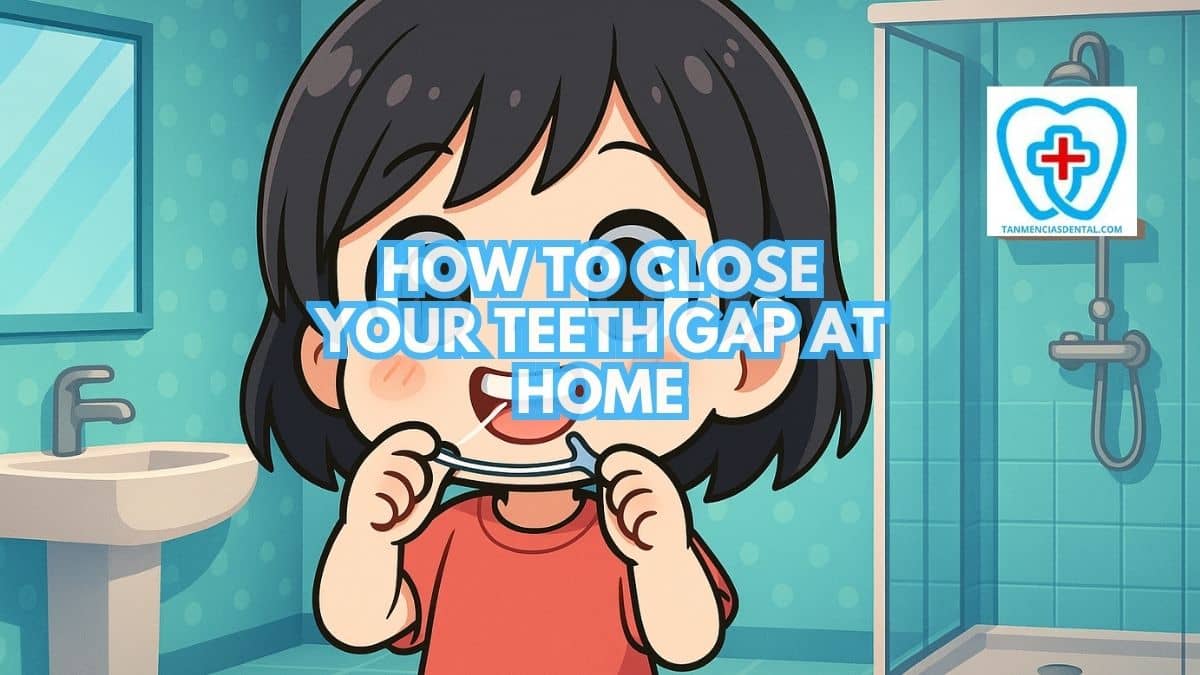Many people search for ways on “how to close your teeth gap at home,” hoping to avoid dentist visits.
However, there are many myths mixed with real solutions online.
Knowing the difference helps avoid problems and disappointment.
Some people try tricks that seem easy but end up causing more harm than good.
We’ll clearly explain which home ideas are safe and which are not.
1. Causes Of Teeth Gaps (Diastema)
Teeth gaps, also called diastema, can happen for different reasons.
Genetics often play a big role, meaning the gaps run in families.
Other causes include habits like thumb-sucking or pushing the tongue against the teeth.
Gum disease can also lead to tooth movement and create spaces.
Understanding the cause is important for choosing the right treatment.
🦷 How to Close Gaps in Teeth Naturally
2. No Quick Or Permanent Home Fixes
Some products and tricks claim to close teeth gaps quickly, but they usually don’t work for long.
These home fixes often don’t solve the real problem and can even damage your teeth or gums.
Moving teeth safely takes time and should be guided by a professional.
Even if a gap seems to shrink, it can reopen later.
Permanent results almost always require dental care.
🦷 Beyond Bad Breath: The Devastating Effects Of Not Brushing Teeth
3. Importance Of Good Oral Hygiene
Brushing and flossing daily helps prevent gum disease and keeps teeth in place.
Healthy gums reduce the chance of teeth shifting, which can cause or worsen gaps.
Still, oral hygiene alone won’t make a current gap go away.
It plays a key role in supporting any treatment you might choose later.
A clean mouth helps all dental work last longer and work better.
🦷 Why Choosing the Right Stuff to Eat After Wisdom Teeth Removal Matters for Healing
4. Oil Pulling Benefits And Limitations
Oil pulling involves swishing oil, like coconut oil, in your mouth to improve cleanliness.
It can help lower bacteria levels, freshen breath, and improve gum health.
However, it cannot move teeth or close gaps.
Some people confuse a clean feeling with real results, but it’s only a support method.
Oil pulling should never replace professional dental advice.
🦷 Did You Brush in Vain? The Truth About Eating After Brushing Teeth
5. Tongue And Smile Exercises For Minor Improvement
Exercises like pressing your tongue on the roof of your mouth or smiling widely can strengthen face and mouth muscles.
These habits might gently influence tooth position in growing children.
In adults, these exercises have limited value and won’t close larger gaps.
They may help improve oral posture or reduce certain habits that cause gaps.
Still, they are not a substitute for dental treatment.
🦷 Can Eating After Tooth Extraction Cause Complications?
6. Risks Of Using Dental Bands At Home
Using rubber bands to pull teeth together is dangerous and not recommended.
The bands can slip under the gums and damage the bone or roots of teeth.
This can lead to infection, tooth loss, or permanent damage.
Dentists have treated many injuries caused by this method.
Any tool that shifts teeth should only be used under expert care.
🦷 How Long Does It Take to Fix A Chipped Tooth?
7. Diet’s Role In Oral Health, Not Gap Closure
Eating fruits, vegetables, and foods rich in vitamins helps support healthy teeth and gums.
These nutrients keep gums strong and lower the risk of gum disease.
However, food cannot shift teeth or close existing gaps.
A good diet keeps your mouth in shape for any dental work you might need.
Think of diet as a helper, not a solution.
🦷 How Much to Fix A Chipped Tooth Without Insurance?
8. Temporary Effects Of Over-the-Counter Bonding Kits
Some bonding kits sold in stores claim to close gaps, but they are often poorly made.
These kits use low-quality materials that may fall off or irritate your gums.
They don’t last long and usually don’t look natural.
Since they’re not made for your mouth, the results can be uneven or uncomfortable.
For safer, better results, it’s best to see a dentist.
🦷 How Long Does It Take to Fill Cavities?
9. Effectiveness Of Professional Dental Treatments
Dentists offer safe ways to close teeth gaps, such as braces, clear aligners, and bonding.
These treatments are designed to move teeth gently and in the right direction.
When done correctly, they give long-lasting and natural-looking results.
Dentists also check for problems like gum disease before starting.
This careful planning makes the treatment safer and more successful.
🦷 How Do Dentists Get Rid of Cavities?
10. Consulting A Dentist Before Trying Home Remedies
It’s always smart to talk to a dentist before trying to fix a teeth gap at home.
They can tell you which methods are safe and which could be harmful.
A dentist can also spot other dental problems that might affect your treatment.
This advice helps prevent pain, damage, and wasted money.
Even one visit can help you make a smarter choice.
🦷 Your Marikina Dental Practice
👨⚕️ Conclusion
Trying to fix a teeth gap at home may seem simple, but most methods don’t work well or can be unsafe.
A few might offer small changes, but they take time and have limits.
Dentists have the right tools and knowledge for long-term results.
Fixing a gap the wrong way can cause bigger dental problems.
Always check with a professional to find the safest and most effective solution.
😊 Self-Promotion
Come visit us at Tan-Mencias Dental Clinic, located at 44 G. Del Pilar Street, Parang, Marikina City.
We’re here to help you with cleanings, checkups, braces, and more.
If you have any questions, you can call us at 0917-145-1074.
You can also send us a message through our Facebook page or our website’s contact form.
We’re always happy to help you smile with confidence!

